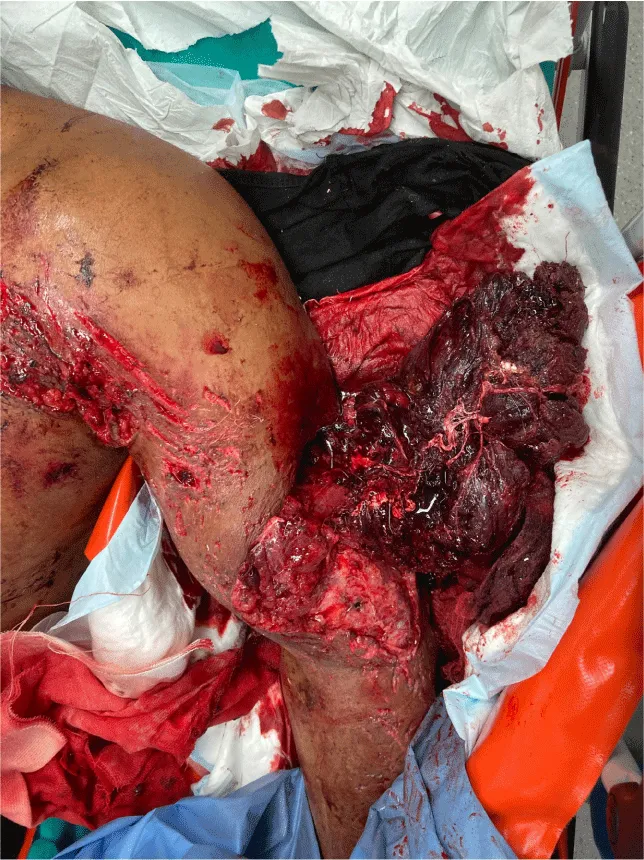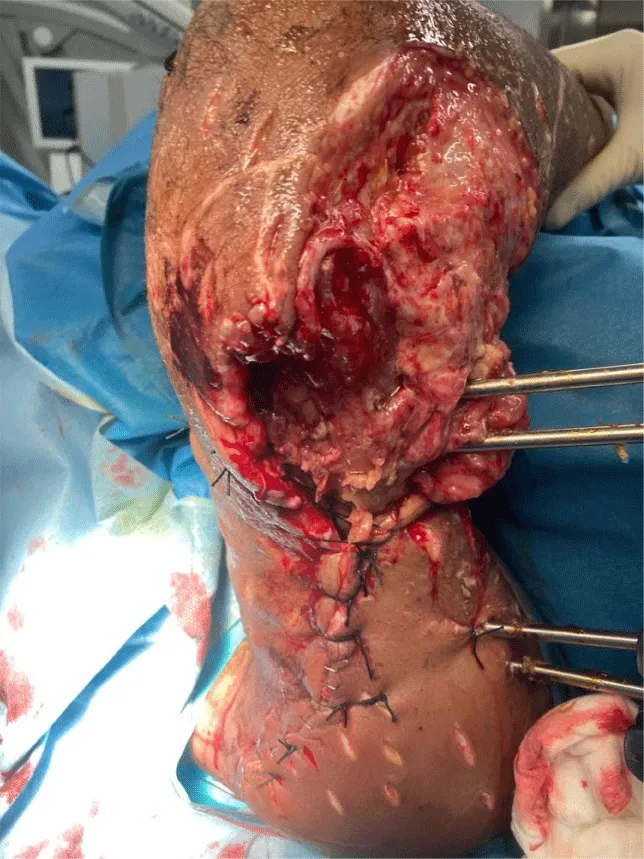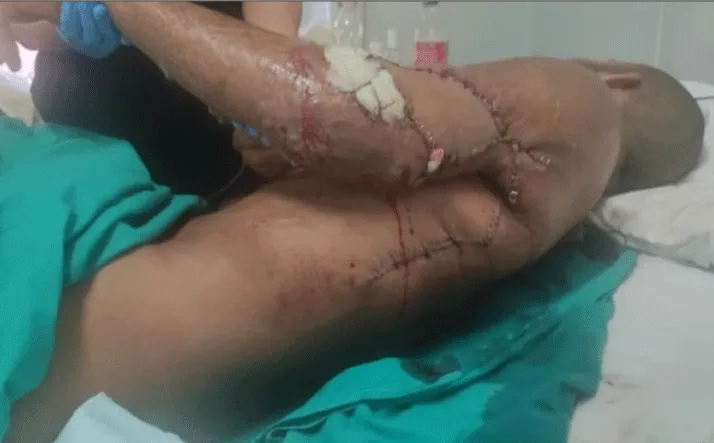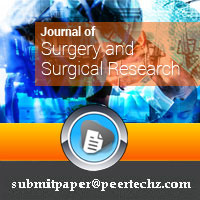Journal of Surgery and Surgical Research
Innovative Approach to Upper Limb Salvage: Ozone Therapy and Surgical Lavage in Action. A Case Report
M Mascia1, M Mazzocchi1*, D Passador1, E Pariani1, E Scalamandrè1, G Forini2, F Cuzzocrea2 and A Locatelli3
1Department of Anesthesia and Intensive Care Unit 3, IRCCS Foundation Policlinico San Matteo, Pavia, Italy
2Orthopedics and Traumatology Clinic, IRCCS Policlinico San Matteo Foundation, 27100 Pavia, Italy
3Cardio-Thoracic-Vascular Department, Anesthesia and Intensive Care Unit 3, IRCCS Foundation Policlinico San Matteo, Pavia, Italy
Cite this as
Mascia M, Mazzocchi M, Passador D, Pariani E, Scalamandrè E, Forini G, et al. Innovative Approach to Upper Limb Salvage: Ozone Therapy and Surgical Lavage in Action. A Case Report. J Surg Surgical Res. 2024;10(2):042-044. Available from: 10.17352/2455-2968.000166Copyright
© 2024 Mascia M, et al. This is an open-access article distributed under the terms of the Creative Commons Attribution License, which permits unrestricted use, distribution, and reproduction in any medium, provided the original author and source are credited.Upper limb injuries after major trauma often result in severe damage to bones, vessels, nerves, and soft tissues, leading to critical challenges in management. The decision between limb salvage and amputation is complex, especially in the context of a "mangled" extremity, which significantly affects functional, psychological, and social well-being. This case report details the innovative use of oxygen-ozone therapy combined with surgical management in a 34-year-old male who suffered a catastrophic injury to the left upper limb after a car crash. The patient presented extensive soft tissue loss, multiple open fractures, and severe infection leading to septic shock and multiorgan failure. Initial treatment included surgical lavage, Vacuum-Assisted Closure (VAC) therapy, and targeted antibiotics. Given the critical condition and the high risk of limb amputation, daily oxygen-ozone therapy was introduced through major autohemotherapy. The treatment resulted in rapid clinical improvement, including hemodynamic stabilization, reduction of inflammation, and enhanced wound healing. Definitive osteosynthesis and flap grafting were performed successfully 42 days post-admission. At the one-year follow-up, the patient demonstrated preserved hand and wrist function with some limitations in flexion and pronosupination. This case highlights the potential of oxygen-ozone therapy as an adjunct in limb salvage, offering a promising alternative to amputation in severe upper extremity trauma. Future research will be necessary to validate these findings and establish standardized protocols for such novel interventions.
Introduction
The upper limb is essential for daily activities, relying on coordinated movement among the shoulder, elbow, forearm, and wrist [1]. Severe upper limb injuries, especially “mangled” extremities affecting bones, vessels, nerves, and soft tissue, have serious implications for functionality, mental health, and social well-being [2]. Major trauma to the upper limb is life-altering and can lead to long-term disability [3]. Treatment decisions between salvage and amputation are complex, as current scoring systems are mainly based on lower limb trauma, leaving a lack of guidance for upper extremities [4,5]. Limb salvage, if pursued, can be a lengthy process with risks of revisions or secondary amputation [5]. This case report illustrates successful limb salvage using a novel combination of ozone therapy and surgery.
Case presentation
A 34-year-old man was admitted after a car accident, presenting with a severe wound to the left arm and forearm, significant tissue loss, and multiple fractures (humerus, ulna, olecranon, acromion, and scapula) (Figure 1). Emergency surgery involved osteosynthesis and wound lavage (Figure 2). The vascular assessment revealed an ulnar artery occlusion, though revascularization was not required. The patient soon developed septic shock with multiorgan failure, requiring norepinephrine for stability. Lab results showed elevated WBC (38,160/μL), CRP (35.71 mg/dL), PCT (32.9 ng/mL), and CPK (21788 mU/ml). Intraoperative cultures detected multidrug-resistant pathogens, necessitating targeted antibiotic therapy. Surgical lavage exposed necrotic and purulent areas in the arm. VAC therapy was applied to enhance healing.
Given the severity, daily oxygen-ozone therapy was initiated via major autohemoinfusion with a mixture of 500 ml blood and 500 ml of oxygen-ozone at 40 mcg/ml. After the first session, clinical stability improved, with reduced necrotic tissue and inflammation. Treatment continued daily for 10 days, then twice weekly for two weeks, resulting in further clinical improvement, decreased inflammation, and normalized renal function. On day 42, definitive osteosynthesis and flap grafting were performed (Figure 3). Post-surgery, the patient regained substantial arm function and was discharged to a rehabilitation center.
Discussion
Decisions about limb salvage versus amputation in severe upper limb trauma are multifaceted, depending on injury extent and patient status. In this case, oxygen-ozone therapy proved beneficial alongside surgery and medical therapy, supporting successful limb salvage. Ozone therapy is known for its antimicrobial, anti-inflammatory, and regenerative effects [6,7]. As a disinfectant and oxygen donor, it promotes nitric oxide synthesis, enhancing blood flow and wound healing [8]. Ozone can also activate stem cells, aiding in tissue regeneration [9]. Notably, while hyperbaric oxygen therapy has been documented as beneficial in similar contexts [10], this is the first report to highlight the application of ozone therapy in the management of a mangled upper limb.
In this case, improvements in clinical markers following ozone therapy indicate its value in severe infection management and healing. Additionally, the one-year follow-up revealed preserved extension and flexion of the wrist and fingers as well as maintained peripheral sensitivity, while deficits in flexion and pronosupination were still present. The multidisciplinary approach, combining surgical debridement, antibiotics, VAC therapy, and ozone, highlights the potential of integrating innovative therapies to optimize outcomes. However, more research, including large-scale trials, is needed to define ozone therapy’s role in trauma care.
Conclusion
Major upper extremity trauma remains a challenging clinical scenario, particularly when weighing the options of limb salvage versus amputation. This case underscores the potential of a multidisciplinary approach that integrates oxygen-ozone therapy with advanced surgical and medical treatments. The use of ozone therapy contributed to significant clinical improvement, promoting wound healing and reducing systemic inflammation in the context of severe infection and soft tissue loss. The successful salvage of the limb, despite the critical initial condition, demonstrates the potential for ozone therapy to act as a valuable adjunct in managing complex trauma cases.
In conclusion, oxygen-ozone therapy represents a promising, cost-effective, and safe adjunctive treatment for limb salvage in severe trauma. Its integration into clinical practice, supported by robust evidence, could significantly impact the decision-making process and the outcomes in major extremity injuries. Further research is essential to refine this approach and validate its role in trauma management.
Ethical declarations
Consent for publication was obtained by the patient.
- Amis AA. Part 1. Upper limb function, shoulder, and elbow. Curr Orthop. 1990;4(1):21-26. Available from: https://doi.org/10.1016/0268-0890(90)90028-E
- Prasarn ML, Helfet DL, Kloen P. Management of the mangled extremity. Strateg trauma limb Reconstr. 2012;7(2):57-66. Available from: https://doi.org/10.1007/s11751-012-0137-4
- National Clinical Guideline Centre (UK). Major Trauma: Assessment and Initial Management. London: National Institute for Health and Care Excellence (NICE). 2016. Available from: https://pubmed.ncbi.nlm.nih.gov/26913320/
- Miller EA, Iannuzzi NP, Kennedy SA. Management of the Mangled Upper Extremity: A Critical Analysis Review. JBJS Rev. 2018;6(4). Available from: https://doi.org/10.2106/jbjs.rvw.17.00131
- Nayar SK, Alcock HMF, Edwards DS. Primary amputation versus limb salvage in upper limb major trauma: a systematic review. Eur J Orthop Surg Traumatol. 2022;32(3):395-403. Available from: https://doi.org/10.1007/s00590-021-03008-x
- Giuliani G, Ricevuti G, Galoforo A, Franzini M. Microbiological aspects of ozone: Bactericidal activity and antibiotic/antimicrobial resistance in bacterial strains treated with ozone. Ozone Ther. 2018;3:48–51. Available from: http://dx.doi.org/10.4081/ozone.2018.7971
- Izadi M, Kheirjou R, Mohammadpour R, Aliyoldashi MH, Moghadam SJ, Khorvash F, et al. Efficacy of comprehensive ozone therapy in diabetic foot ulcer healing. Diabetes Metab Syndr. 2019;13:822–5. Available from: https://doi.org/10.1016/j.dsx.2018.11.060
- Bocci VA, Zanardi I, Travagli V. Ozone acting on human blood yields a hormetic dose-response relationship. J Transl Med. 2011;9:66. Available from: https://doi.org/10.1186/1479-5876-9-66
- Bocci VA. Scientific and medical aspects of ozone therapy. State of the art. Arch Med Res. 2006;37(4):425-35. Available from: https://doi.org/10.1016/j.arcmed.2005.08.006
- Jirangkul P, Baisopon S, Pandaeng D, Srisawat P. Hyperbaric oxygen adjuvant therapy in severe mangled extremities. Injury. 2021;52(11):3511-3515. Available from: https://doi.org/10.1016/j.injury.2021.06.033
Article Alerts
Subscribe to our articles alerts and stay tuned.
 This work is licensed under a Creative Commons Attribution 4.0 International License.
This work is licensed under a Creative Commons Attribution 4.0 International License.





 Save to Mendeley
Save to Mendeley
